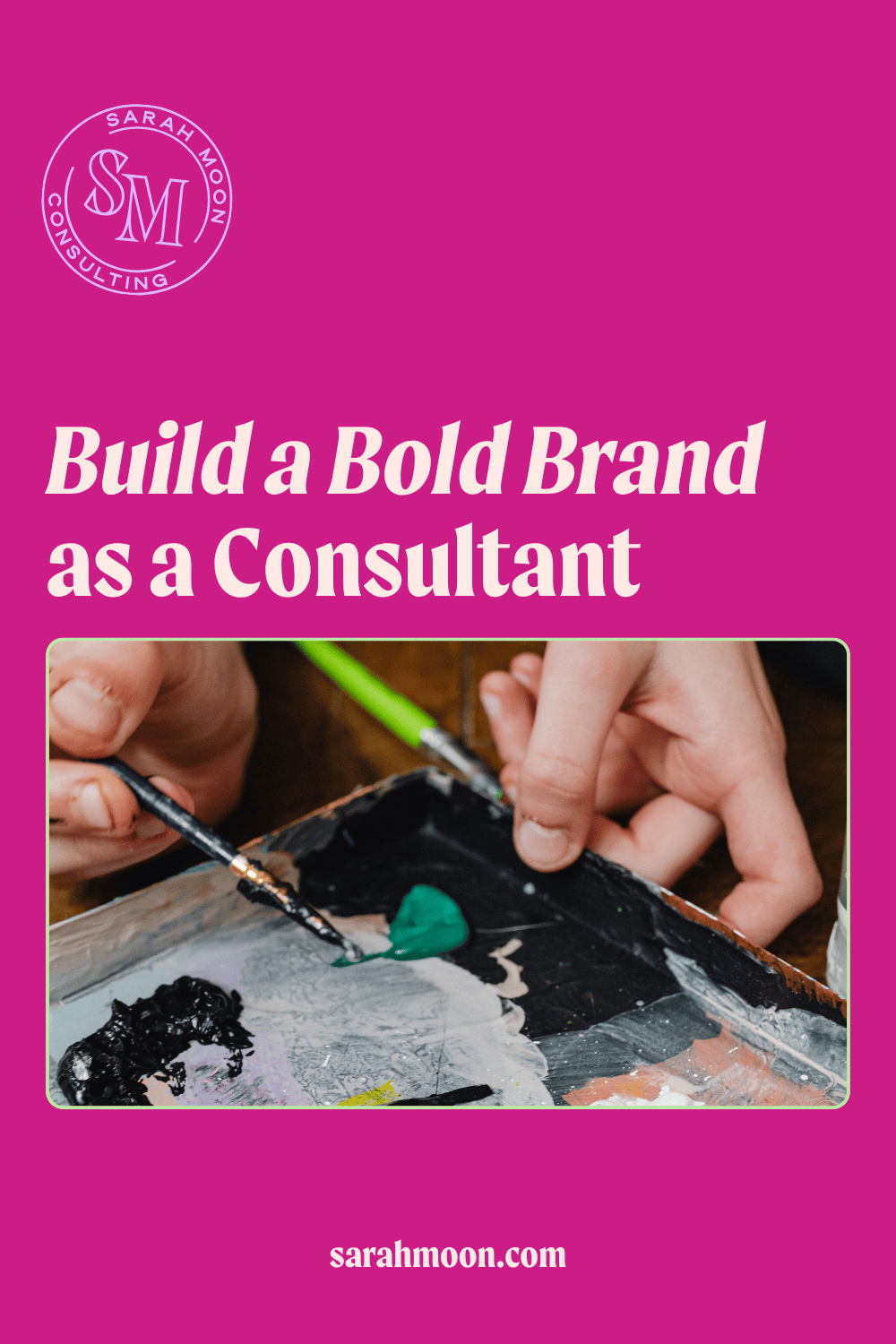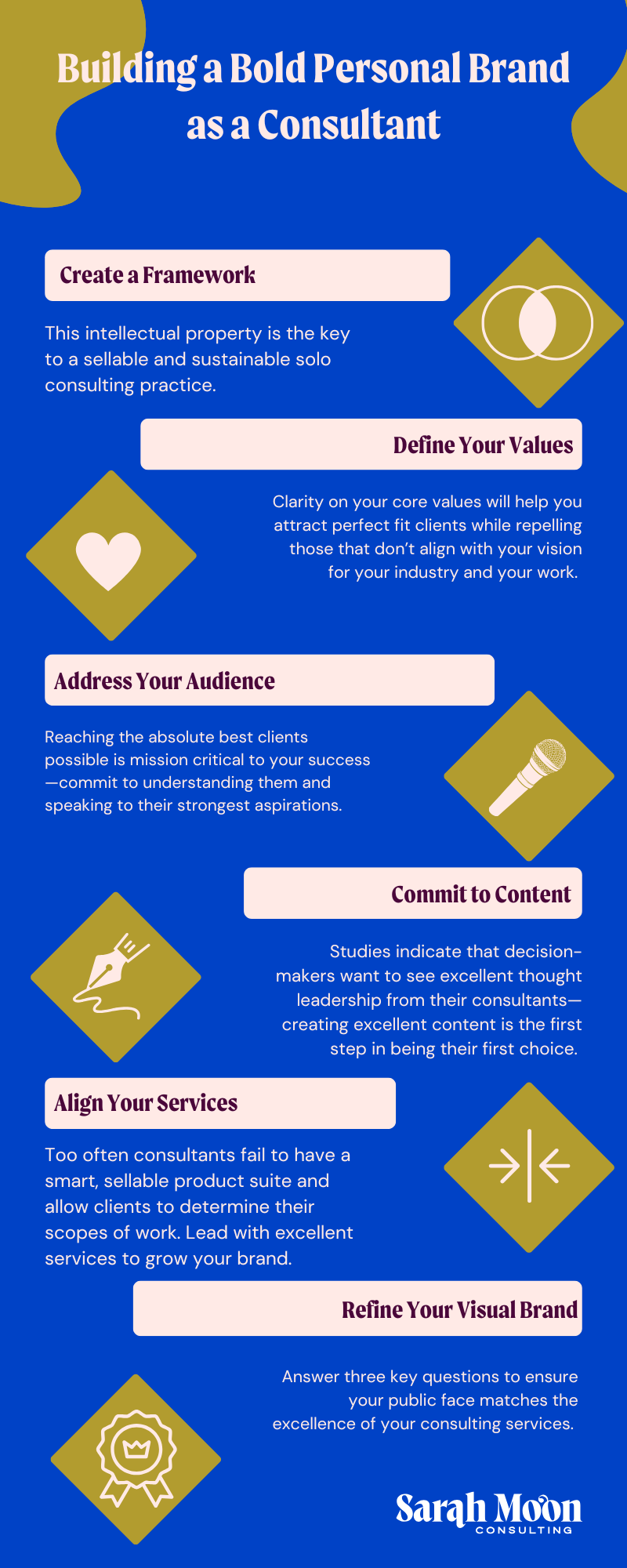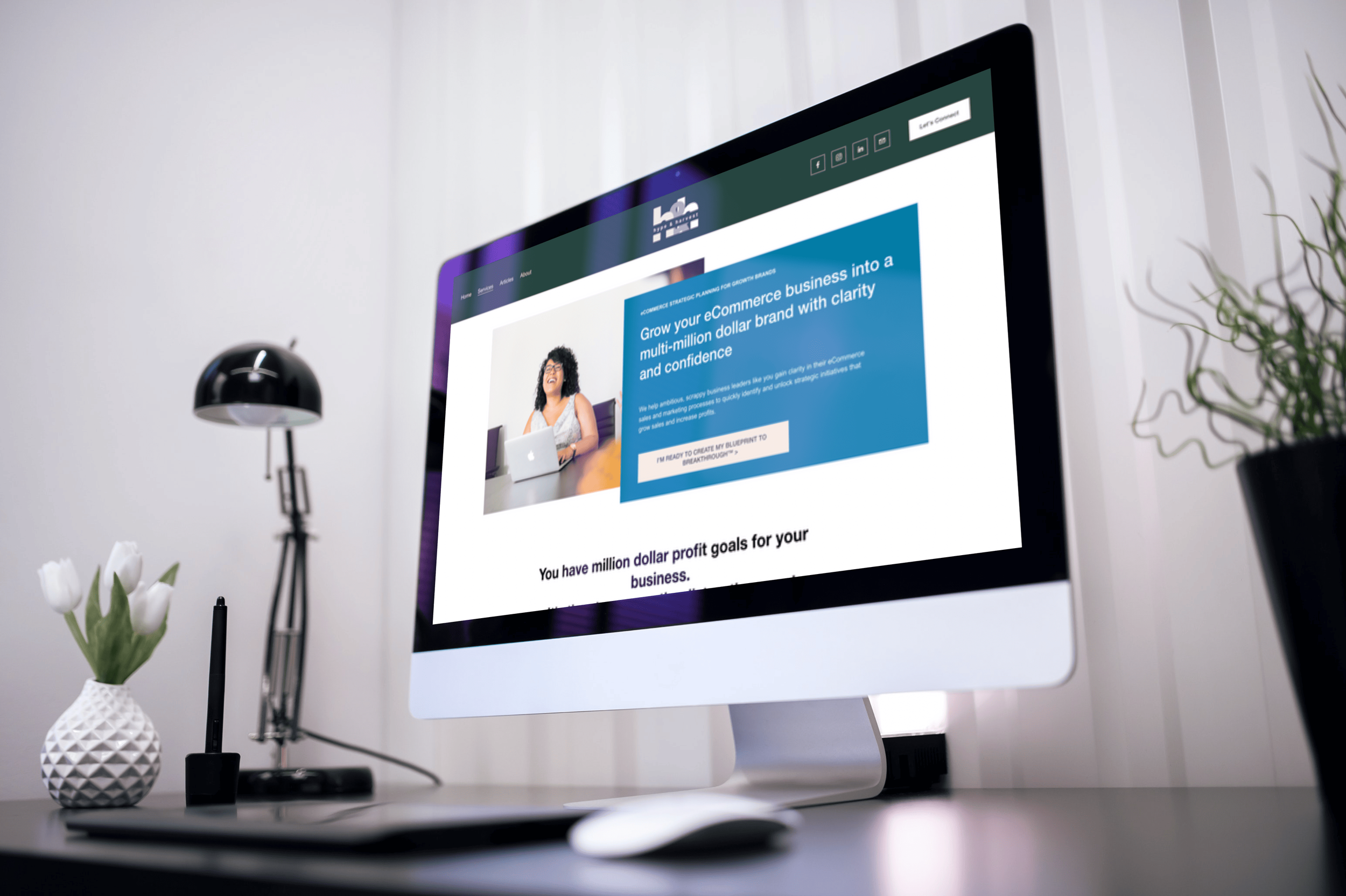How to Build a Bold Personal Brand as a Consultant
In today's noisy consulting landscape, standing out is a non-negotiable. Great clients want to hire consultants with a strong point of view and perspective (aka a personal brand) and this is key to attracting new clients, landing projects that pay you for the value you bring to the table, and establishing yourself as a thought leader in your field.
Ready to take your consulting business to the next level? Then make the time to get serious about developing an intentional consultant personal brand.
But that's easier said than done. Many coaches and consultants will tell you "show up," "post more," "be consistent," but none of those things are actually personal brand building. Will they get you a few clients? Grow your list? Maybe—but it's not the path to building a sustainable personal brand as a consultant. In short, showing up is NOT a strategy.
As a highly-skilled consultant, you probably find yourself frustrated when you see less experienced consultants landing coveted clients because they are so good at selling themselves—and it's probably due to a thoughtfully-developed personal brand. Like it or not, this matters in today's business landscape, and I'd rather play the game and do meaningful work than dig in my heels and let the competition pass me by.
Let's dive into how to begin thinking about building a bold and memorable brand as a consultant.
First, it's critical to understand that your personal brand as a consultant and marketing are two different things entirely.
Marketing is the strategic plan and the accompanying tactics that fuel discovery, connection, belief, and ultimately sales of your consulting services.
This strategic marketing plan should be fueled by your personal brand.
Too often we see new and even seasoned consultants focus on marketing tactics such as logos, photoshoots, and graphics before developing a clear expression of their personal brand. And I get why: these feel like tangible actions versus personal branding which definitely feels awkward and ephemeral.
Secondly, keep in mind that you and your personal brand as a consultant are intertwined but not the same thing.
You can infuse as much or as little of yourself as a person into your personal brand. I share a lot of myself as part of my personal brand building, but your level of comfort with that is yours and yours only.
What you do need to know, however, is that your personal brand encompasses important elements such as your movement, your methodology, and your vision for the industries and clients you serve.
In short, your personal brand is what makes you unforgettable as a consultant.
Now that we've clarified the difference between your personal brand as a consultant and your marketing strategy, let's talk about what tangible foundations you need to create a vibrant personal brand as a consultant.
It's likely you already have all of these assets in your toolkit, but you've not purposefully leveraged them to build your personal brand as a consultant.
Often when we're "in it" as part of our day to day work with consulting clients, we just don't see how significant these elements are. That's why I want you to write them down and share these pieces joyfully with you audience (more on them in a minute).
Step One: Create a consulting methodology or framework that makes you stand out.
You knew this was coming, didn't you? A framework or methodology that's documented and shared is a non-negotiable. Too many consultants reply on endless discovery calls and massive lists of deliverable to convey their value when a clear, understandable methodology can do that heavy lifting.
Imagine you can get on a call with a potential client and instead of listing off everything they're going to get from you, you walk them through the transformation you'll create using your signature model. When this happens, the entire dynamic of the relationship shifts and they can see the value beyond just the work that you're doing—this leads to your value being absolutely crystal clear and allows you to charge premium rates.
What's a model or framework for consulting? It's a simple, visual way to explain the transformation you're making and the process the audience moves through.
This is ours, it's called the Alignthority® System.
Our Alignthority® framework drives everything we do: from marketing to conversations with leads to our actual services—it's like jet fuel for our business.
My client Nic, a website strategy consultant, said this about using her framework:
"I knew I needed a framework around what I was selling and the way I was framing my work so that I could properly put things into buckets, and if things didn't belong in the buckets, they had to just go."
Nic Sidoti, Studio Clvr
In short, if you're not operating with a framework in your consulting business, you're doing things on Hard Mode.
Step Two: Define Your Consulting Practice's Core Values
Your core values are the first step in clarifying your audience, and ensuring you're doing the right work for the right people. The most common reason I see consultants struggling with dissatisfaction is because they simply do not align with the clients they're reaching. The work feels like a slog, and every client interaction feels tenuous.
This often comes down to misaligned values. And these values don't have to be big weighty concepts—one of our core values is "Embrace Curiosity." This came about because I discovered that incurious clients were poor fits for our company. Because we come at our work from a place of curiosity and examination, if a client isn't on board with that, we'll struggle to find a rhythm in our collaboration. That doesn't mean that they're poor clients or bad people—it simply means we're not the right marketing strategy company for them.
How do you define your core values as a consultant?
I recommend this simple exercise:
Get a piece of paper—yes, paper!
On one side, write, "What I stand for:"
On the other side, write, "What I'm against:"
Set a time for twenty minutes and brain dump on each side of the paper.
Set it aside until the next day.
The next day, come back to your sheet of paper and look at it with fresh eyes:
What are the patterns?
Do you see common themes?
What stands out as important?
Make a list of 5-10 concepts that are the most important.
This work will form the foundation for your core values as a consultant. Some of the concepts will scare off certain clients if you've taken this work seriously. This is a good thing! We only want well-aligned clients in our worlds, right?
After that, these values should be shared on your website—the about page is the typical place, but it's up to you. This work is pretty meaningless if it's not shared with the world.
For extra credit: Think about how you can leverage this work into your content strategy and thought leadership. This will absolutely make your consulting brand stand out in a crowd!
Step Three: Address Your Audience as a Consultant
You're an experienced pro, so I don't have to tell you that your audience isn't "Everyone." That goes without saying. However, that doesn't mean that it's not crucial to identify important qualities in your audience and who you serve best.
The question I ask my Spark Sessions clients is,
"Who is the highest and best client you can help?"
That's who you need to talk to day in and day out. Sure, you may reach and sign some folks who aren't in that sphere, but we're keeping our eyes on this peak client at all times. My client Nequosha, an attorney and business consultant, talks about this a lot—she could serve people who were more established and sophisticated, but common practice said she shouldn't aim so high.
“It was either making content for people in the beginning [stages]. And not making enough content for the people in the beginning [at a] higher level. But [the] client avatar that lit me up was at the higher level, but yet everyone kept telling me, you need to have this educational content. And so my brain went to basics, but that’s not what I needed to do. I need to answer questions for my higher-level client.”
Nequosha Anderson, Attorney & Business Consultant
However, it turns out, the more sophisticated audience was hungry to have someone speak to them and their needs. Too often people look downwards to build an audience, at the beginners and the DIYers, leaving successful and sophisticated clients only served by large firms.
Building a bold personal brand as a consultant isn't difficult—but it does take intention and purpose.
And yet, many very successful companies prefer to work with solo consultants or micro firms because they love the personalization and care they receive over a larger firm. They know they're not just another line item in the balance sheet but they look around and see that most solo consultants are speaking only to new businesses.
For you and your consulting business, this is an opportunity. Study the language of your ideal client—follow them on LinkedIn or Threads or wherever they hang out. Consider joining associations and really learning the lingo and nuances so you can speak to them both personally and in your marketing right where they're at.
Addressing your audience is an ongoing, iterative process that's mission-critical to building a bold personal brand as a consultant, and it should be part of your weekly work ON your business.
Step Four: Commit to Creating Content for Your Consulting Business
Thought leadership is the key to landing the best consulting clients—full stop.
The data backs this up over and over again. Decision-makers over and over again say that very little of the thought leadership they find provides them with anything useful or insightful (source: Edelman Thought Leadership Impact Report). And yet, these same decision-makers consider excellent thought leadership as contributing significantly to the value of a consultant's services (also, per Edelman).
What we have here is an Authority Gap that you can capitalize on with your personal brand as a consultant.
If you haven't developed a handful of core themes to build your thought leadership around, consider this your sign to do just that. The easiest way to do so is to lean on that pesky framework and your audience's own natural language to develop a topic cluster that proves to your audience that you're not only the right choice, you're the ONLY choice. You become a category of one.
(Spoiler alert: That's exactly the aim of this article you're reading. I looked around at other guides to personal brand development for consultants and, in my view, they missed the mark completely. So, by writing this article, I have created search-fueled thought leadership for you, speaking directly to you, a consultant who's thinking about personal branding because of you will say, "Yes! Sarah gets it!")
I strongly encourage our clients who are consultants to not only think about thought leadership based content, but weaving in search engine savviness to help amplify their viability, since we know 90 percent of internet experiences start with a search. I love this example from our SEO student Trina, who has a very serious institutional audience, but nevertheless takes a bold a memorable stance about strategic planning and what it means to take a modern approach to this work. (You can learn about the best way to this in our SEO Funnel Strategy Workshop.)
Why not double-dip your marketing by also leveraging the search engine and make life easier?
Step Five: Align Your Consulting Services to Your Personal Brand
One of the most toxic habits of Big Consulting that bleeds into the solo and micro firm world is hourly billing and client-driven scopes or work.
This model works for large firms because they can charge big bucks by the hour and then farm the work out to fresh-faced junior consultants.
This business model does not work for visionary solo practitioners and it will—yes, will—harm you and your consulting practice's personal brand beyond repair if you emulate it.
I dive into how to package consulting services more deeply elsewhere, but you're going to need to develop delivery mechanisms that are efficient for you and effect for your client.
Some of my favorite options for packaging and delivery of consulting services include:
Day rates or VIP days to dive deeply into a challenge.
Productized services that deliver a specific solution to a common problem.
Tightly structured recurring intensives instead of vague retainers.
A comprehensive, time-blocked engagement akin to what we do in our Alignthority® Accelerator.
Retainer access limited to a specific communication channel such as Slack Connect or Voxer—a Consultant on Call type engagement. (I offer this to my private clients and it's a beloved tool for asynchronous support. No scheduling, no fuss, just help when it's needed.)
A "phone a friend" type model that serves as a taste-tester for your methodology and style (this is what my one-off Strategy Consulting Sessions are).
Train the trainer offers—this means training people within your clients' companies to deliver what you deliver. You can even offer licensing of materials for some nice recurring revenue. (Get your ducks in a row first—we have a free webinar with my own IP attorney that touches on this.)
Lunch and learns and similar time-blocked collaborations. These can serve as lead magnets into your larger offers, but also be very lucrative for consultants as standalone offers.
Notice what's missing here? You've got it: that employee-like embedding in your clients' businesses. Over and over again I see consultants burn out from that mode of delivery or find their business is devastated when a Whale Client cancels a contract and they haven't diversified their revenue streams.
Acting like an employee in your clients' businesses is extremely high risk and if you do so, make it worth your while and charge accordingly.
Regardless of what you select, curate your offer stack—much like a tech stack—into the essentials that are joyful to delivery and easy to sell. This doesn't mean that you won't create a custom proposal here and there, but it will be simply expanding on what you have, not building from scratch each and every time.
Step Six: Refine Your Consulting Business' Visual Identity
After you've done all this work in defining your personal brand as a consultant, you'll likely find that your visual presence needs some TLC—and this is fine! Do not skip ahead to this step, however! I love visual identities and brand expression, but too often folks focus on this before they've done all the personal brand development work we've outlined above.
Audit your visual assets such as your website, brand/logo, photos, and similar and ask yourself a few questions:
Does this visually speak to my highest and best client (remember our question from Step Three)?
Looking at the competition, do I stand out visually? Will potential clients remember me or do I look the same as everyone else in my field?
Will this serve me as I grow? Do I have the assets I need to thrive as a fully developed personal consulting brand?
The answers to these three simple questions create your working list for enhancing your visual brand expression.
That doesn't mean you need to run out an hire an expensive brand designer to overhaul everything, but it does mean that you can plan for strategic improvements over time. Or, perhaps just tweaking using a resource like our former course called The Magical Homepage Formula will get you where you need to be, like our student Amber, an e-commerce consultant, of Hype & Harvest did.
Amber's site states her ideal clients' biggest goals—calling in ambitious business leaders to her services.
Amber speaks directly to her specific audience—using their language.
Amber added her framework to her services page, to demonstrate how thoughtful she's crafted her methodology.
Oftentimes, my clients will tell me that they plan on overhauling everything once they have the funding to do so, but we are able to make small adjustments and tweaks such as colors and typography to elevate what they have to give them more time to grow their businesses. Or, we'll recommend a great Squarespace template, such as those that my friend Kate Scott offers (I'm an affiliate but they're excellent templates)—templates can be great stop gaps while you plan a full brand design down the line.
Or, if it's your logo or brand mark that's making you feel not quite ready, an off the shelf logo such as those my friend Alyssa of Amp'd Designs or my friend Lindsey of Six Leaf Designs offer can be great options that will last you until you're ready to dive deeply into brand work.
The takeaway here is that this an opportunity for you to really think about what you need to have a bold and distinctive brand, but also give yourself space to grow. Too often I see people not move forward because they're too fixated on their visual brand and they neglect more important elements such as their framework and offers.
Beyond each of these steps, the singular key takeaway I want you to leave with is that building a bold personal brand as a consultant is non-negotiable.
It's an iterative process that's never really "done." As you gain more knowledge, refine your perspective, and grow your consulting practice, so will your personal brand. And, this work will allow you to have more freedom and flexibility in the future.
With a bold personal brand you can confidently move into paid speaking engagements, authoring books, or leverage your intellectual property with courses and infoproducts. The sky is the limit if you do this work now.











Thinking about building a marketing and business strategy? Not so fast! Your first stop is tackling these three challenges.